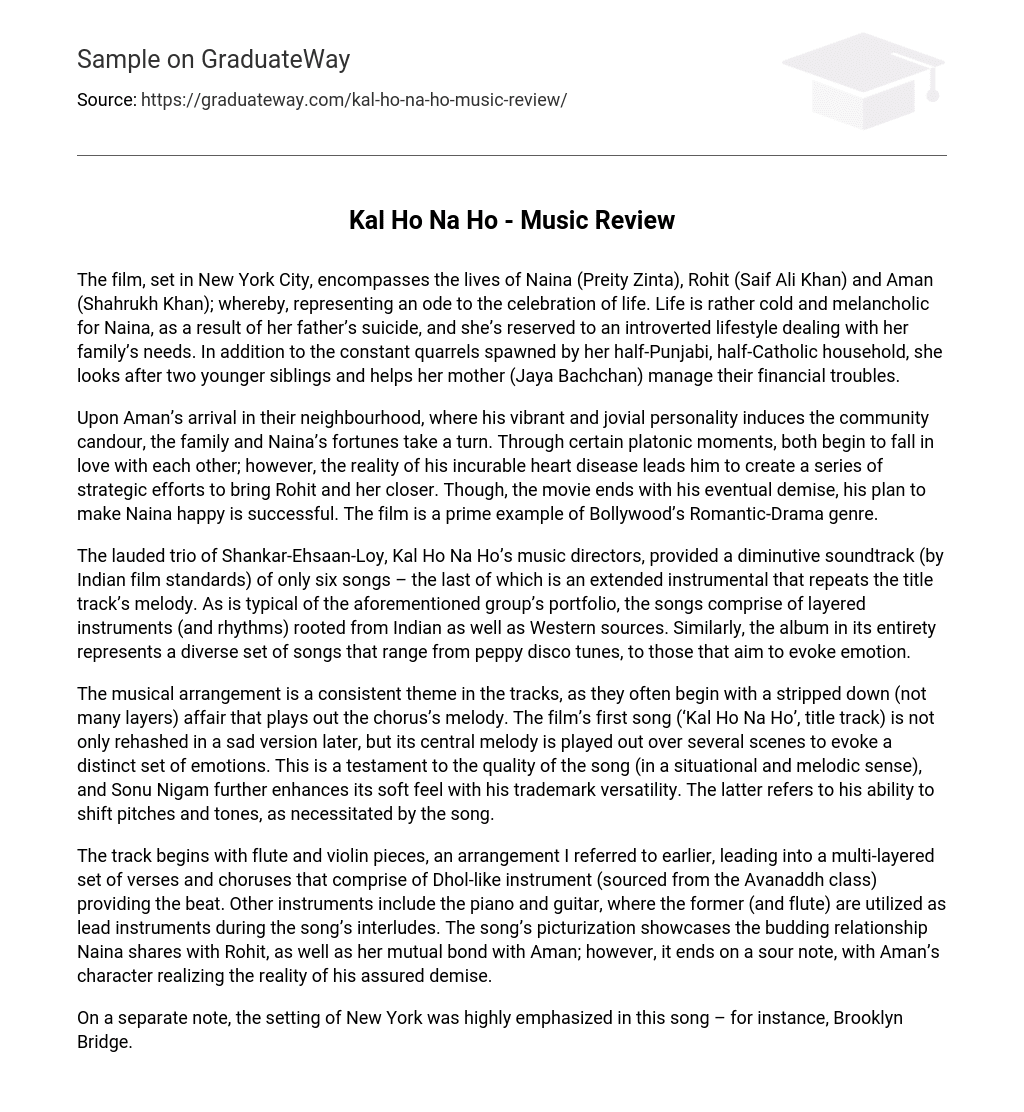The film, set in New York City, encompasses the lives of Naina (Preity Zinta), Rohit (Saif Ali Khan) and Aman (Shahrukh Khan); whereby, representing an ode to the celebration of life. Life is rather cold and melancholic for Naina, as a result of her father’s suicide, and she’s reserved to an introverted lifestyle dealing with her family’s needs. In addition to the constant quarrels spawned by her half-Punjabi, half-Catholic household, she looks after two younger siblings and helps her mother (Jaya Bachchan) manage their financial troubles.
Upon Aman’s arrival in their neighbourhood, where his vibrant and jovial personality induces the community candour, the family and Naina’s fortunes take a turn. Through certain platonic moments, both begin to fall in love with each other; however, the reality of his incurable heart disease leads him to create a series of strategic efforts to bring Rohit and her closer. Though, the movie ends with his eventual demise, his plan to make Naina happy is successful. The film is a prime example of Bollywood’s Romantic-Drama genre.
The lauded trio of Shankar-Ehsaan-Loy, Kal Ho Na Ho’s music directors, provided a diminutive soundtrack (by Indian film standards) of only six songs – the last of which is an extended instrumental that repeats the title track’s melody. As is typical of the aforementioned group’s portfolio, the songs comprise of layered instruments (and rhythms) rooted from Indian as well as Western sources. Similarly, the album in its entirety represents a diverse set of songs that range from peppy disco tunes, to those that aim to evoke emotion.
The musical arrangement is a consistent theme in the tracks, as they often begin with a stripped down (not many layers) affair that plays out the chorus’s melody. The film’s first song (‘Kal Ho Na Ho’, title track) is not only rehashed in a sad version later, but its central melody is played out over several scenes to evoke a distinct set of emotions. This is a testament to the quality of the song (in a situational and melodic sense), and Sonu Nigam further enhances its soft feel with his trademark versatility. The latter refers to his ability to shift pitches and tones, as necessitated by the song.
The track begins with flute and violin pieces, an arrangement I referred to earlier, leading into a multi-layered set of verses and choruses that comprise of Dhol-like instrument (sourced from the Avanaddh class) providing the beat. Other instruments include the piano and guitar, where the former (and flute) are utilized as lead instruments during the song’s interludes. The song’s picturization showcases the budding relationship Naina shares with Rohit, as well as her mutual bond with Aman; however, it ends on a sour note, with Aman’s character realizing the reality of his assured demise.
On a separate note, the setting of New York was highly emphasized in this song – for instance, Brooklyn Bridge. ‘Maahi Ve’ (meaning my beloved one) is a distinctly peppy track – reflected by its up-tempo arrangement as well as the positivity of its lyrics and tone. Shankar-Ehsaan-Loy display their atypical knowledge of Western music by utilizing a plethora of instruments, including the synthesizer, flute, saxophone, and electric guitar. A synthesized drum beat introduces the song, accompanied by a redundant electric tune played throughout, leading to a chorus filled with a dhol-induced drum beat and subtle (electric) guitar chords.
The two percussion beats and electric tune continue through the verses, while the interludes include the saxophone, flute, and Indian string instrument (Tat class). Vocalists like Sadhna Sargam, Sujata Bhattacharya, Sonu Nigam, Udit Narayan and Shankar Mahadevan collectively render the song in a diverse manner, as the broad array of voices altered its tone and appealed to different emotions. Also, from a picturization standpoint, different voices where aligned with specific characters; thereby, enhancing the situational aspect of the song.
The movie was taking on a positive tone at this point, as characters are shown as remitting to the optimism of the moment. ‘Kuch To Hua Hai’, following ‘Pretty Woman’ (an Indian rendition of Roy Orbison’s original track) and ‘It’s The Time To Disco’, is important for two reasons: it signals the album’s shift to softer and more emotional songs, and reflects the emergence of a love triangle between Aman, Rohit and Naina. Sung by a duo of premiere vocalists (Shaan and Alka Yagnik) known for their amorous-driven voices, the piece effectively exudes the emotion of love and appiness. A mid-tempo arrangement that maintains relatively few instrumental layers (mostly playing major scales) further enhances the latter. A basic drum loop serves as the percussion throughout the song, while being accompanied by the flute, piano (during the interlude), and an instrument from the strings family (slightly indiscernible). The aforementioned music trio demonstrate their versatile, compositional abilities with this song, particularly when compared to the two that take place before it.
In terms of picturization, it machinates a simple set of scenes that display the characters’ happiness with regard to their budding relationships. From a historic standpoint, it vaguely illustrates Bollywood’s formulaic development of romance between characters within the interval of a song. In summation, the film’s soundtrack – though complete with film music’s leading members and a set of likeable tracks – is certainly lacking in terms of providing something unique and ingenious. The size of the project and its success are key factors why the songs remained as popular as they did, in my opinion.





